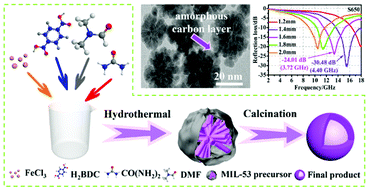Excellent lightweight carbon-based microwave absorbers derived from metal–organic frameworks with tunable electromagnetic properties†
Abstract
Metal–organic frameworks (MOFs) have attracted extensive interest owing to their tunable compositions and large specific surface areas. Herein, Fe3O4@carbon and Fe3C@carbon composites were fabricated from iron-based MOFs (MIL-53(Fe)) via a facile hydrothermal and calcination process. Based on the Gibbs free energy theory, nanocrystal transformation from Fe3O4 to Fe3C can be well controlled when the calcination temperature is above 689 °C, revealing that the temperature plays key roles in improving the electromagnetic parameters and microwave absorbing performance. Using elaborately designed MIL-53(Fe) as a precursor for carbon-based lightweight microwave absorbers, a minimum reflection loss (RLmin) value of −30.48 dB at a very thin matching thickness of only 1.4 mm and an effective microwave bandwidth of 4.40 GHz (from 13.6 to 18 GHz) can be achieved. It is believed that this work can arouse interest to further exploit metal–organic frameworks for lightweight carbon-based microwave absorbers.

- This article is part of the themed collection: 2020 Inorganic Chemistry Frontiers HOT articles


 Please wait while we load your content...
Please wait while we load your content...